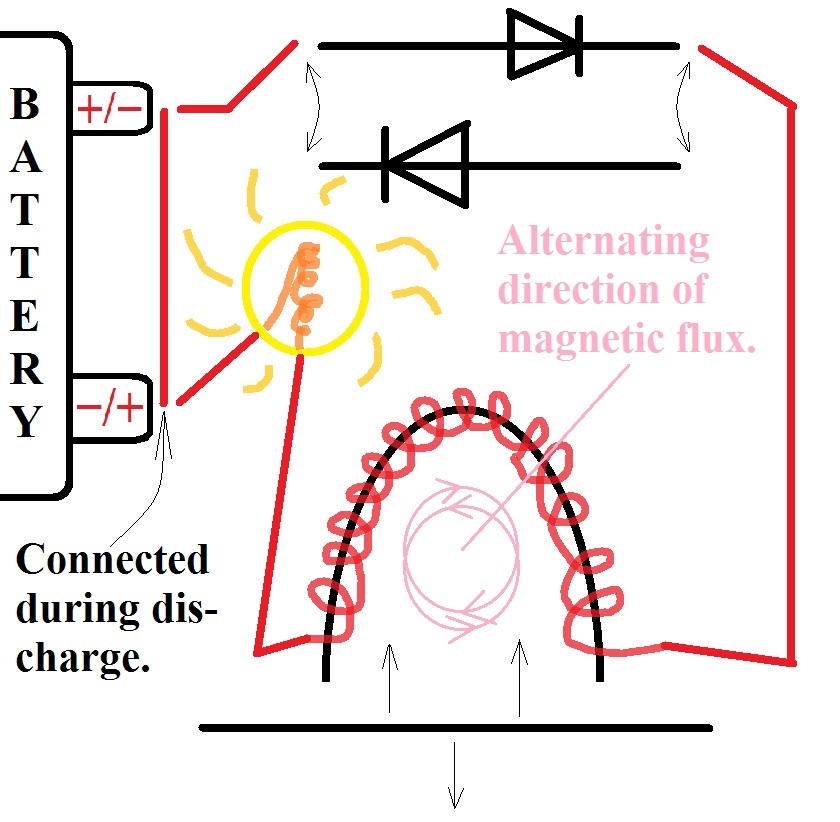Oops...
We have /a/ perpetual motion /holder/ sitting under our collective noses within each and every AC transformer...




I may never figure out how Tesla's Special Tri-Metal Generator works, but in the course of trying to figure out one thing, very often something else miraculously happens...
Not too many people have done the correct experiment to validate that transformers can respond to a DC current. Consequently, conventional wisdom has it that transformers only respond in an AC manner. Yet, if we professed to know what AC is, then we'd have to confess that AC is the rapid reversal of two distinct DC's during each half cycle of an AC system.
Paul Babcock did the standard / conventional, one half of the following experiment when he visited the Science, Energy and Technology Conference of 2013. He had Ed Leedskalnin's Perpetual Motion Holder experiment set up off to the side of the lecture hall.
The other half of a DC transformer experiment is to put two diodes in the middle of a double-pole, double throw switch inline with one lead coming off the PMH coil/s and the other lead that goes to the battery during charge. The other lead from the PMH coil/s could go to the light bulb and thence toward the other battery terminal during the charge cycle when these two bare battery leads are not bound together during discharge (which also lights up the light bulb). The light bulb lights up twice: during both charge and discharge.
An AC transformer has its primary and secondary coils separated. The DC transformer uses one coil to perform both charge and discharge of its combination straight bar plus horseshoe iron circular core.
An AC transformer terminates the first half cycle by electromagnetically breaking its iron core ring every 1/120th of a second (in a 60Hz electrical system) by attempting to recharge the transformer's core with a reverse current. For some reason, the energy which was put into the iron core at the start of the prior 1/120th of a second can't change its auto-pilot, DC habit of zipping around the toroidal core in its one particular DC direction without exiting the core, instead. This makes way for the new energy of reverse polarity to enter the system through the primary coil windings while the secondary coil absorbs some of the exiting energy put in during the prior AC half-cycle.
Up until now(?), the only way to duplicate the electrical termination of the first half cycle of an AC transformer within the context of a DC demonstration, was to physically break the circularity of the PMH/DC transformer ring by removing the straight iron (magnetizable) bar at the end of the two legs of the iron (magnetizable) horseshoe.
The diodes are to validate, by way of experimentation, that only two out of eight combinations are possible to light up the light bulb twice during both charge and discharge of the horseshoe/bar ring.
An AC transformer does one whole cycle 60 times a second (in north America). And anyone with basic understanding of electricity has no conventional guidance on how to go about measuring the characteristics of a DC transformer. So, we're led to believe that DC transformers don't exist.
Oops...
We have /a/ perpetual motion /holder/ sitting under our collective noses within each and every AC transformer...





I'll warrant that back EMF is nothing other than a PMH discharge already latent within a pre-magnetized(?), or magnetizable(?), material?
Natural perpetual motion is all around us...
This would imply that perpetual motion exists all around us as a pre-existing property of matter. Magnetizable material, permanent magnets, and conductors of electric fields wound as spirals to cut across themselves (thus, inverting their electric field into a magnetic field) are all interfaces with the perpetual motion latent within every material. But it's the special properties of electrical conductors, such as: metallic substances, which manage to this property more so than others. Back EMF is an indication of this.
Resistance within a conductor of an electric field is a pre-condition to back EMF. This sounds like a contradiction to perpetual motion unless magnetism is the ability to harness the perpetual motion within atomic, or electron, spin?
Electric resistance within a conductor - and magnetic resistance within a magnetizable substance, such as: iron - may be the result of attempting to insert energy with an orientation, of a spiral or spin, into a material which is opposed to giving up one half of its randomly assorted, spiral or spin orientation. This would include most substances which are either conductive or magnetizable. In an electrical conductor, it's still opposed to the application of inverted spin, but at least it's willing to give up some of its pre-existing spiral or spin orientation in the form of resistive heat. In a magnetizable material, such as: iron, it is willing to give up some of its pre-existing spiral or spin orientation by giving up some of its pre-existing magnetic orienctation since it's undergoing a process of receiving new energy anyway (in a transformer, or iron cored coil winding). So, electrical conductors and magnetizable substances are adaptably willing to both give and receive electromagnetic energy making them good mediums of energy exchange (which is the definition of money!).
|
| Pages: 0 · 1 · 2 · 3 · 4 · 5 · 6 · 7 |

| Pages: 8 · 9 · 10 · 11 · 12 · 13 · 14 |
|
|---|